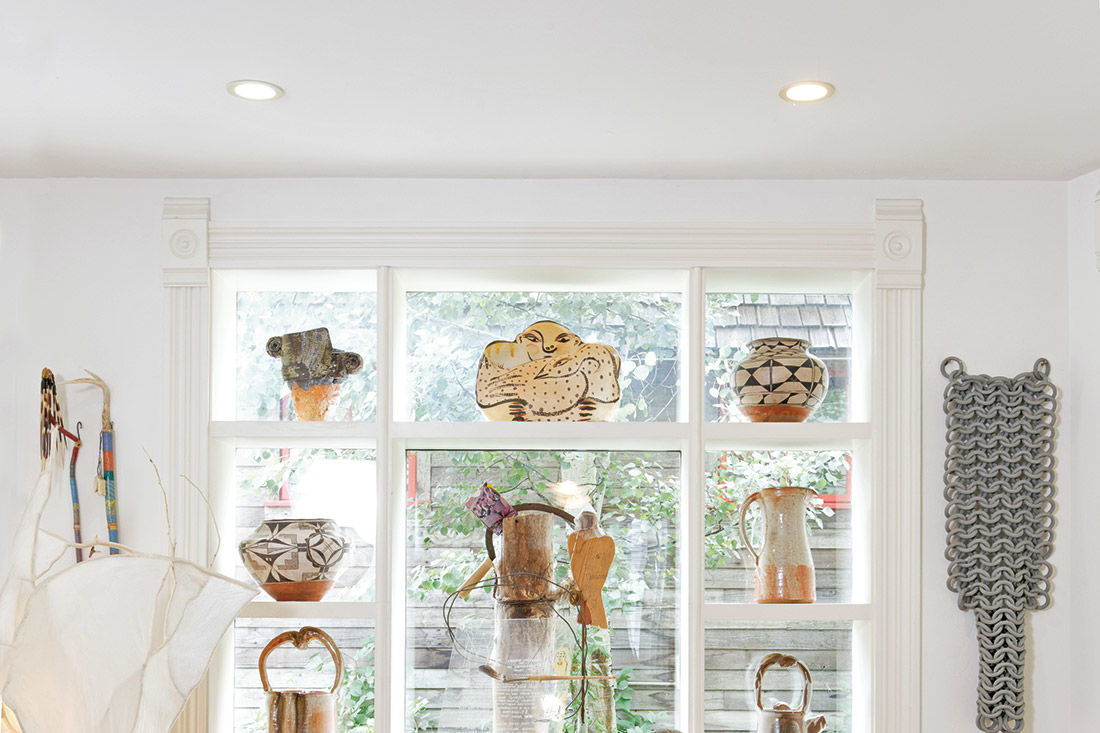
This Old Art House a.k.a. "The Observatory House"

The Hoffmans with grandsons Kiefer and Bridger. The window display features a selection of the couple’s extensive ceramic arts collection.
On a cement-gray afternoon in September, three generations of Hoffmans are gathered in the family room of Sharon and John Hoffman’s Aspen home, engaged in one of their favorite pastimes—discussing art. Eleven-year-old Kiefer, the eldest of the Hoffmans’ three grandchildren, is recounting the story of his first acquisition, procured at the Anderson Ranch annual art auction in Snowmass Village. While attending the event with his grandmother, the then nine-year-old got the go-ahead to bid on his object of desire—but on one condition: he would have to sit quietly through the remainder of the event. The auction went on for another two hours. Keifer recalls the experience as being “really hard.”
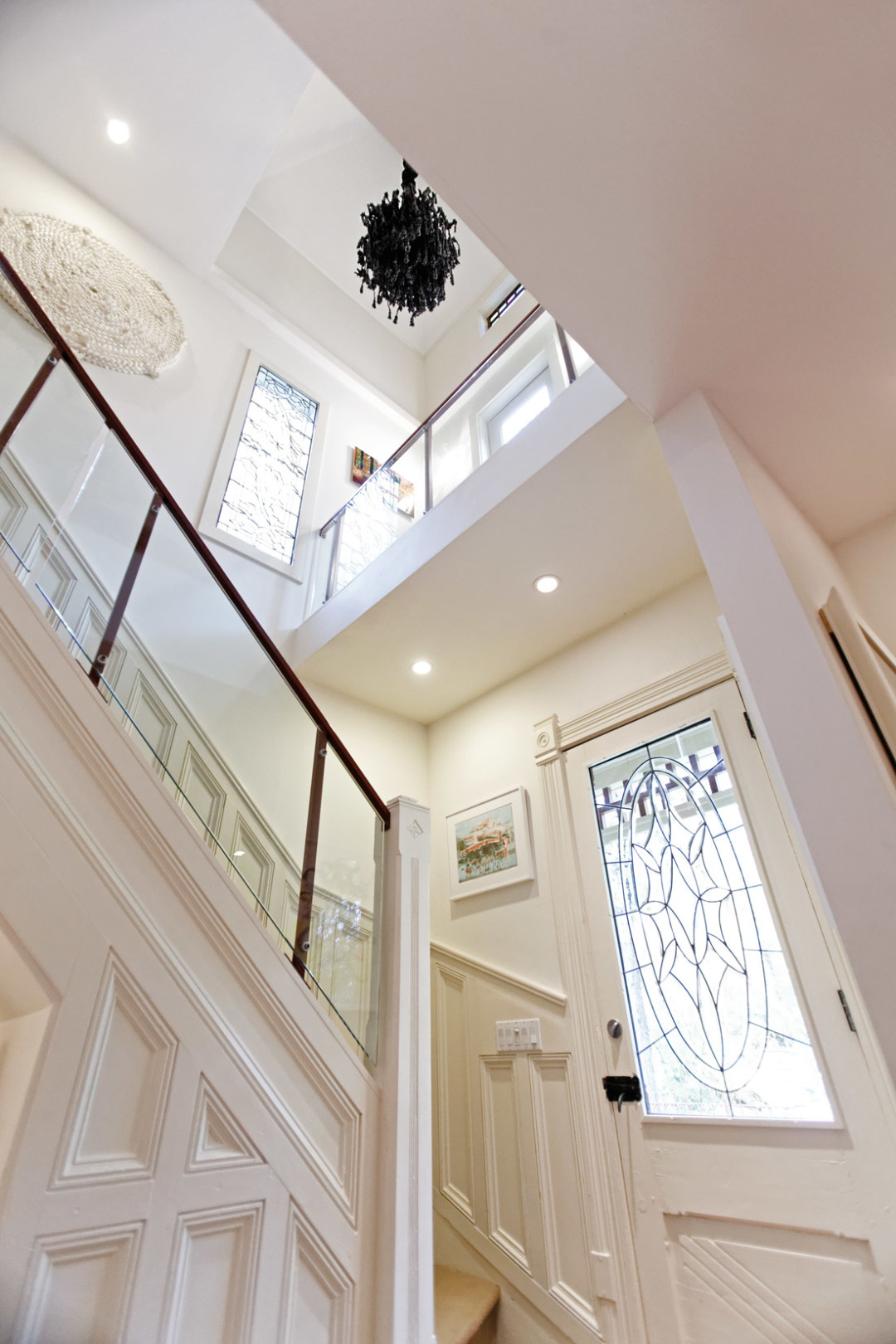
The second-story floor over the stairwell was removed during the remodel to allow light from high windows to flood the entry. A sculpture by Petah Coyne, named Max after an early benefactor, suspends from the third floor ceiling. On the stair wall hangs Diana Ross’s Hair by Nadine Robinson.
Even so, the boy’s forbearance paid off. By the end of the long day he was the proud owner of an LED baseball book by the noted Korean artist Airan Kang. The piece remains on permanent display in his bedroom back home in New York.
The Hoffman progeny, it seems, are gleaning a lesson imparted to the senior Hoffmans long ago by their late mentor, the noted art collector and scholar Ralph T. Coe: “If you want to be serious collectors, you have to listen and learn before you go out and do something stupid,” John recalls. Surrounded by a trove of thought-provoking works by emerging and established artists, the youngsters clearly have a lot to learn from.
Besides offering a visual narrative of the Hoffmans’ nearly five decades of acquiring art, the collection reveals the couple’s long-held interest in African-American artists. Where convention might call for a crystal chandelier, for example, a Petah Coyne sculpture hangs from the ceiling. At the end of the second-floor hallway is a signature door piece by Radcliffe Bailey that pays tribute to Bailey’s ancestors. Diana Ross’s Hair, by Nadine Robinson, hangs on the stair wall. The piece suggests nothing so much as an enormous coil of rope, painted white; flip a switch and out waft the first nine bars of the theme song from Mahogany, Ross’s 1975 film.
“The African-American narrative is so important in the culture and politics of this country,” John explains. Sharon later adds, “We like to buy emerging artists and often buy out of one of their first shows. It is particularly rewarding to get to know them, continue a friendship, and watch their careers grow.”
Judged solely by its exterior, the residence would seem an unlikely showcase for a contemporary art collection. Built in 1881, the original structure stands as one of Aspen’s oldest houses. What you see from the outside is a demure, exquisitely restored Victorian (no mega-addition metastasizing off the back here). Commonly known as the Observatory House, the residence is considered an Aspen landmark for the rooftop observatory its previous owner, a Mrs. Elizabeth Jones, had installed circa 1973 as a Christmas gift to her teenage son.
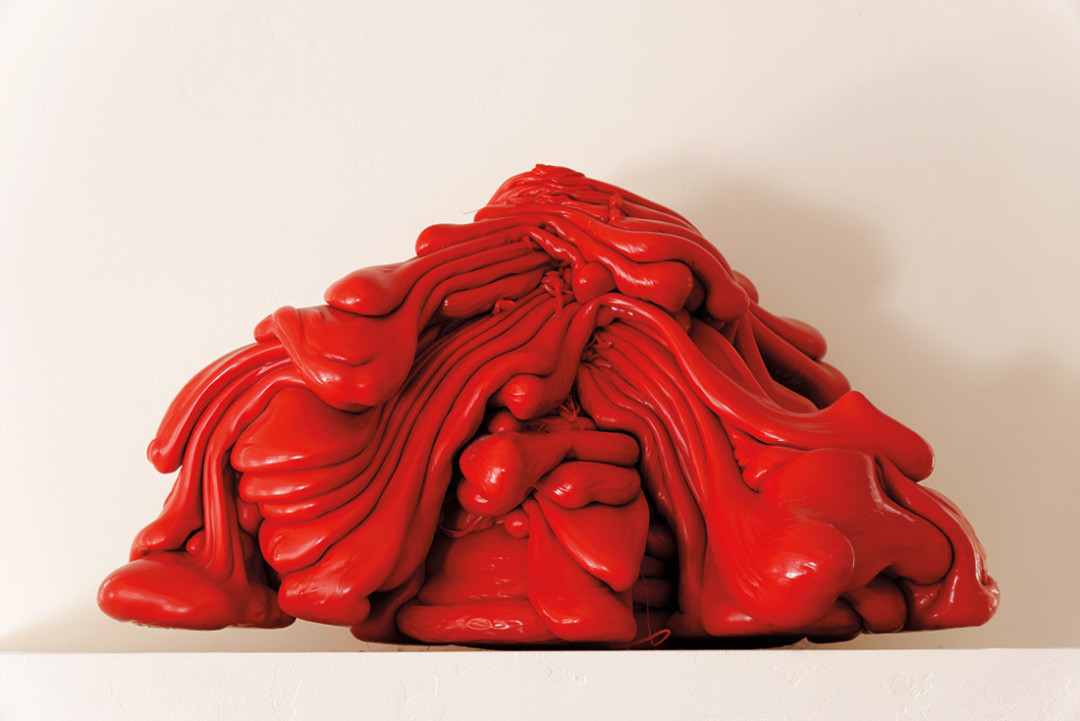
This hardened resin sculpture is part of Roxy Paine’s Scumak (Auto Sculpture Maker) series. The forms were generated from a computer-operated machine programmed by Paine to blend plastic with pigment before extruding the mix onto a conveyor belt at intervals, rendering each piece similar but unique.
Sharon and John Hoffman began visiting the Aspen area regularly in the early 1980s. Attracted by a thriving arts and culture scene, the two were drawn especially to the innovative ceramic work being produced by Anderson Ranch founder Paul Soldner and associates. In their native Kansas City, where they maintain a primary residence, the Hoffmans have also spent decades cultivating a passion for historic architecture, with John serving as president of the Kansas City Preservation Foundation for many years.
After enjoying shared ownership with friends in a summerhouse in Aspen’s West End, by 2001 the Hoffmans were eager to have a home in town of their own. Meanwhile, the Observatory House had fallen into something of a state of disrepair. When it became available later that year, the couple spotted a rare opportunity—in more than a century the residence had changed hands only four times—and “a jewel in the junk,” says John. They snapped it up before it ever went on the market.
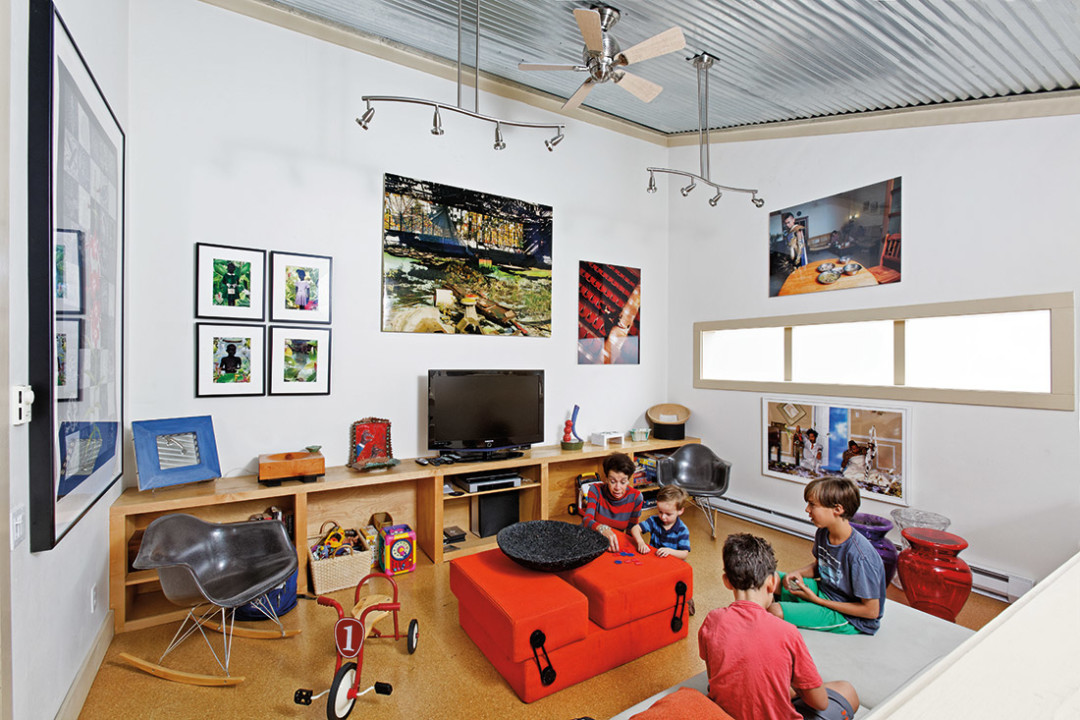
The playroom at the back of the house gives grandchildren plenty of room to be kids while also providing wall space for the Hoffmans’ burgeoning collection of fine art photography, a sector of collecting to which they were introduced by their son, Matt.
With the help of longtime Aspen architect Heidi Hoffmann and contractor Red Rienks, the home underwent a faithful-to-its-roots face-lift on the outside, and a complete transformation on the inside. The goal was to keep the integrity and feel of the home, but open it up so it would be more comfortable for family, while at the same time creating a space for the Hoffmans’ contemporary collection.
The exterior—previously a jaunty, if mildly garish lavender with the observatory a brilliant shade of saffron—was returned to its original nineteenth century palette of soft gray, putty, and garnet. The antique ironwork now gleams. The landscaping is an understated mix of cottonwoods, aspens, and old-growth pines, with a spray of bright perennials. The formerly dark and cramped interiors are today awash with light and air.
Working with the homeowners was “totally refreshing and fun,” says Heidi Hoffmann. “They were extremely knowledgeable and up to the challenge of preserving the exterior of the house. And they looked at the interiors as a blank canvas.” The project earned the architect a 2002 CARE award (Colorado Award for Remodeling Excellence).

John Hoffman found this longhorn and cowhide chair from the 1920s in an antique store. Above it hangs a gift from Christo and Jeanne-Claude commemorating the Wrapped Walkways installation, a project Hoffman was instrumental in bringing to Kansas City in the late 1970s. Below: the dome and telescope that give the home its name.
As John shows me around the house, he speaks animatedly about art, architecture, and the joys—and responsibility—of being arts patrons, a role he and Sharon take seriously. In Kansas City, John was instrumental in bringing the Christo and Jeanne-Claude project Wrapped Walkways to the city; Sharon was a founding board member for Ailey II, one of the nation’s premier showcases for rising African-American dancers. In Aspen, Sharon is curating a show this summer at the Quintenz Gallery. Titled Relevance, the exhibition features work by Nathaniel Donnett, McCallum and Tarry, and Derrick Adams. A former utility-room–turned–bedroom in their Aspen house is dedicated each summer to an Aspen Music Festival student. “We wake to the sound of her doing scales,” John says fondly of the Juilliard student who has lived there the past two seasons.
One of the Hoffmans’ first orders of business upon completing the remodel in 2002 was to host a gathering for the resident artists at Anderson Ranch, a ritual they’ve continued. They also regularly invite Ranch interns over to discuss art as a career. “I encourage them to reach out and push themselves,” says John. “I’m always enthusiastic with them.”
It isn’t hard to imagine those budding artists roaming wide-eyed through the house, drinking in inspiration. Virtually everywhere you look another eye-grabbing curiosity begs closer inspection. Many of the artists in the collection, Petah Coyne included, have lectured or taught at Anderson Ranch over the years. The Hoffmans also enjoy supporting local artists, evident in the coffee and end tables by Carbondale designer Brad Reed Nelson.
And while the collection is composed mainly of narrative art, it extends to the purely conceptual too. A blob of hardened liquid resin roughly the size of a microwave sits atop the media cabinet in the family room. Part of Roxy Paine’s Scumak series, John likes to tell the grandkids “that’s where the ceiling dripped.”
Nearby, perched on deep sills behind the sofa, and backlit by an expanse of east-facing glass (one of the home’s few non-original windows), stand a dozen or so functional and figurative ceramic works. The close proximity of young impulse-prone limbs to all that breakable art might well prove anxiety producing to the average collector. Throughout our conversation various family members—son, daughter, daughter-in-law, grandchildren (the youngest of whom is three)—move in and out of the room with ease. When I mention this to Sharon, she shrugs. “[The grandkids] have toys to play with. They know how to live with art. They ask about it, and know what not to touch. We did the house with grandchildren in mind. If they want to sit on the furniture in their wet bathing suits, we’re fine with it.”
And soon enough, they all head out to the hot tub.
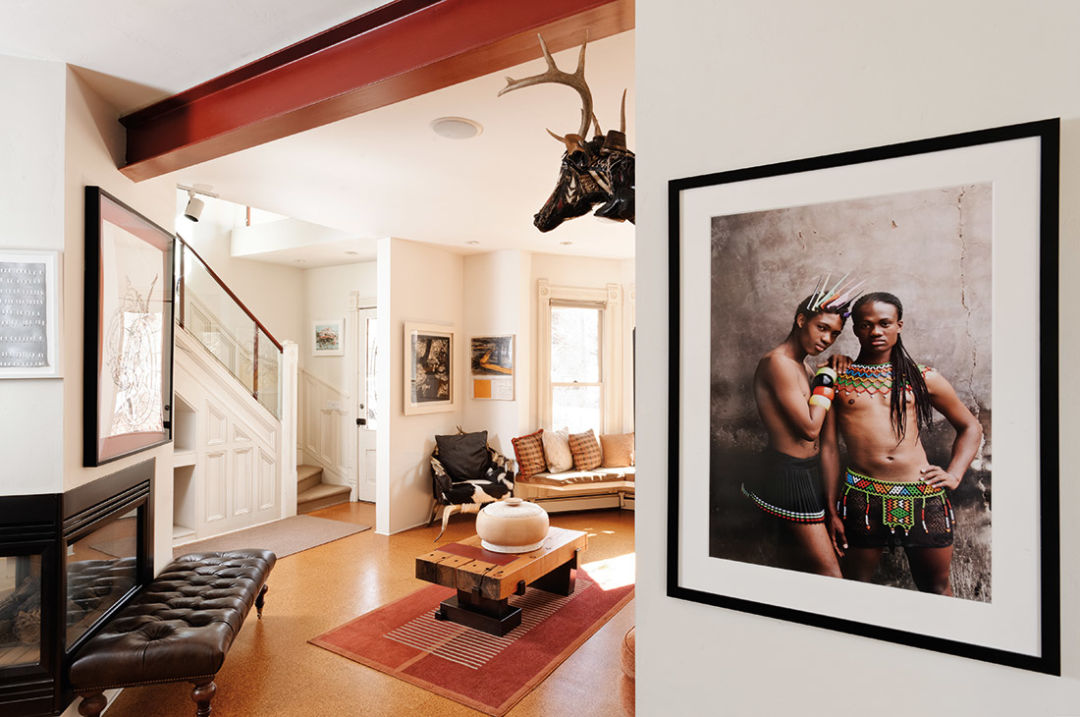
The Hoffmans purchased the photograph by South African artist Zanele Muholi (who spoke last summer at Aspen Ideas Festival) four years ago during a trip to Cape Town. It hangs now on the wall between the dining and living rooms. The couple acquired Ken Little’s mounted “deer head” in the 1980s. Constructed entirely of repurposed cowboy boots, the tongue-in-cheek piece underscores the Hoffmans’ irrepressible sense of humor.














































